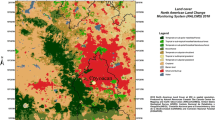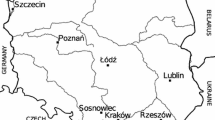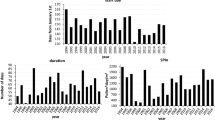Abstract
The present study explores the role of the meteorological variability in the pollen production and the timing of the airborne pollen season by analysis of the correlation between precipitation, insolation and temperature and the main standardised airborne pollen parameters of 22 taxa collected at 6 localities in Catalonia (NE Spain). The pollen parameters included in the study were: Annual Pollen Integral and the Start, End and Length of the Main Pollen Season. Considering that the Main Pollen Season of most of the taxa in Catalonia lasts from spring to summer or autumn, correlations between the pollen parameters and winter (from December to March) values of meteorological variables were calculated. Correlations between Monthly Pollen Integral and monthly values of the meteorological variables were also calculated. The results obtained report the synchronism registered in the variations of pollen concentration with precipitation (negative), insolation (positive) and temperature (positive). Temperature was the meteorological variable that showed a greater influence in the pollen production and the timing of the pollen season, being insolation the least one. The Start of the Main Pollen Season was the pollen parameter more correlated with the meteorological variables, especially with winter temperatures.

Similar content being viewed by others
References
Andersen, T. B. (1991). A model to predict the beginning of the pollen season. Grana, 30(1), 269–275.
Belmonte, J., Alarcón, M., Avila, A., Scialabba, E., & Pino, D. (2008). Long-range transport of beech (Fagus sylvatica L.) pollen to Catalonia (north-eastern Spain). International Journal of Biometeorology, 52(7), 675–687.
Belmonte, J., Vendrell, M., Roure, J. M., Vidal, J., Botey, J., & Cadahía, A. (2000). Levels of Ambrosia pollen in the atmospheric spectra of catalan aerobiological stations. Aerobiologia, 16(1), 93–99.
Cariñanos, P., Galán, C., Alcázar, P., & Domínguez, E. (2004). Airborne pollen records response to climatic conditions in arid areas of the Iberian Peninsula. Environmental and Experimental Botany, 52, 11–22.
Chamecki, M., Meneveau, C., & Parlange, M. B. (2009). Large eddy simulation of pollen transport in the atmospheric boundary layer. Journal of Aerosol Science, 40(3), 241–255. https://doi.org/10.1016/j.jaerosci.2008.11.004.
de Bolòs, O., & Vigo, J. (1990). Flora dels Països Catalans (Vol. II). Ed. Barcino.
Díaz de la Guardia, C. D., Alba, F., Trigo, M. M., Galán, C., Ruíz, L., & Sabariego, S. (2003). Aerobiological analysis of Olea europaea L. pollen in different localities of southern Spain. Grana, 42(4), 234–243.
De Linares, C., Delgado, R., Aira, M. J., Alcázar, P., Alonso-Pérez, S., Boi, M., et al. (2017). Changes in the Mediterranean pine forest: Pollination patterns and annual trends of airborne pollen. Aerobiologia, 33, 375–391.
Duhl, T. R., Zhang, R., Guenther, A., Chung, S. H., Salam, M. T., House, J. M., et al. (2013). The simulator of the timing and magnitude of pollen season (STaMPS) model: A pollen production model for regional emission and transport modeling. Geosci Model Dev Discuss, 6, 2325–2368. https://doi.org/10.5194/gmdd-6-2325-2013.
Fernández-Llamazares, A., Belmonte, J., Alarcón, M., & López-Pacheco, M. (2012). Ambrosia L. in Catalonia (NE Spain): Expansion and aerobiology of a new bioinvader. Aerobiologia, 28(4), 435–451.
Fernández-Llamazares, Á., Belmonte, J., Delgado, R., & De Linares, C. (2014). A statistical approach to bioclimatic trend detection in the airborne pollen records of Catalonia (NE Spain). International Journal of Biometeorology, 58, 371–382.
Fernández-Martínez, M., Belmonte, J., & Espelta, J. M. (2012). Masting in oaks: Disentangling the effect of flowering phenology, airborne pollen load and drought. Acta Oecologica, 43, 51–59.
Frei, T. (1998). The effects of climate change in Switzerland 1969–1996 on airborne pollen quantities from hazel, birch and grass. Grana, 37, 172–179.
Frenguelli, G., & Bricchi, E. (1998). The use of the pheno-climatic model for forecasting the pollination of some arboreal taxa. Aerobiologia, 14, 39–44.
Galán, C., Alcázar, P., Cariñanos, P., Garcia, H., & Domínguez-Vilches, E. (2000). Meteorological factors affecting daily Urticaceae pollen counts in southwest Spain. International Journal of Biometeorology, 43(4), 191–195.
Galán, C., Alcázar, P., Oteros, J., García-Mozo, H., Aira, M. J., Belmonte, J., et al. (2016). Airborne pollen trends in the Iberian Peninsula. Science of the Total Environment, 550, 53–59.
Galán, C., Cariñanos, P., Alcázar, P., & Domínguez, E. (2007). Manual de Calidad y Gestión de la Red Española de Aerobiología. Córdoba: Servicio de Publicaciones de la Universidad de Córdoba.
Galán, C., Smith, M., Thibaudon, M., Frenguelli, G., Oteros, J., Gehrig, R., et al. (2014). Pollen monitoring: Minimum requirements and reproducibility of analysis. Aerobiologia, 30(4), 385–395.
García-Mozo, H., Galán, C., Aira, M. J., Belmonte, J., Díaz de la Guardia, C., Fernández, D., et al. (2002). Modelling start of 10 oak pollen season in different climatic zones in Spain. Agricultural and Forest Meteorology, 110, 247–257.
Garcia-Mozo, H., Galán, C., Jato, V., Belmonte, J., Díaz de la Guardia, C., Fernandez, D., et al. (2006). Quercus pollen season dynamics in the Iberian Peninsula: Response to meteorological parameters and possible consequences of climate change. Annals of Agricultural and Environmental Medicine, 13(2), 209.
Green, B. J., Dettman, M., Yli-Panula, E., Rutherford, S., & Simpson, R. (2004). Atmospheric Poaceae pollen frequencies and associations with meteorological parameters in Brisbane, Australia: A 5-year record 1994–1999. International Journal of Biometeorology, 48, 172–178.
Grinn-Gofroń, A., & Bosiacka, B. (2015). Effects of meteorological factors on the composition of selected fungal spores in the air. Aerobiologia, 31(1), 63–72.
Haroon, M. A., & Rasul, G. (2008). Effect of meteorological parameters on pollen concentration in the atmosphere of Islamabad. Pakistan Journal of Meteorology, 4(8), 27–36.
Heide, O. M. (1994). Control of flowering and reproduction in temperate grasses. New Phytologist, 128, 347–362.
Hirst, J. M. (1952). An automatic volumetric spore trap. Annals of Applied Biology, 39(2), 257–265.
Izquierdo, R., Alarcón, M., Majeed, H. T., Periago, C., & Belmonte, J. (2015a). Influence of atmospheric teleconnection patterns on airborne pollen levels in the NE Iberian Peninsula. Climate Research, 66(2), 171–183.
Izquierdo, R., Alarcón, M., Periago, C., & Belmonte, J. (2015b). Is long range transport of pollen in the NW Mediterranean basin influenced by Northern Hemisphere teleconnection patterns? Science of the Total Environment, 532(2015), 771–779.
Izquierdo, R., Alarcón, M., Mazón, J., Pino, D., De Linares, C., Aguinagalde, X., et al. (2017). Are the Pyrenees a barrier for the transport of birch (Betula) pollen from Central Europe to the Iberian Peninsula? Science of the Total Environment, 575, 1183–1196.
Janati, A., Bouziane, H., Trigo, Md M, Kadiri, M., & Kazzaz, M. (2017). Poaceae pollen in the atmosphere of Tetouan (NW Morocco): Effect of meteorological parameters and forecast of daily pollen concentration. Aerobiologia, 33, 517–528.
Jato, V., Dopazo, A., & Aira, M. J. (2002). Influence of precipitation and temperature on airborne pollen concentration in Santiago de Compostela (Spain). Grana, 41, 232–241.
Jato, V., Rodríguez-Rajo, J., Dacosta, N., & Aira, M. (2004). Heat and chill requirements of Fraxinus flowering in Galicia (NW Spain). Grana, 43(4), 217–223.
Khwarahm, N., Dash, J., Atkinson, P. M., Newnham, R. M., Skjøth, C. A., Adams-Groom, B., et al. (2014). Exploring the spatio-temporal relationship between two key aeroallergens and meteorological variables in the United Kingdom. International Journal of Biometeorology, 58, 529–545.
Kizilpinar, I., Civelek, E., Tuncer, A. et al. (2011). Pollen counts and their relationship to meteorological factors in Ankara, Turkey during 2005–2008. International Journal of Biometeorology, 55(4), 623–631.
Kuparinen, A., Markkannen, T., Riikonen, H., & Vesala, T. (2007). Modeling air-mediated dispersal of spores, pollen and seeds in forested areas. Ecological Modelling, 208(2–4), 177–188. https://doi.org/10.1016/j.ecolmodel.2007.05.023.
Laaidi, M. (2001). Forecasting the start of the pollen season of Poaceae: Evaluation of some methods based on meteorological factors. International Journal of Biometeorology, 45(1), 1–7.
Laaidi, M., Thibaudon, M., & Besancenot, J. P. (2003). Two statistical approaches to forecasting the start and duration of the pollen season of Ambrosia in the area of Lyon (France). International Journal of Biometeorology, 48(2), 65–73.
López, D. J., Belmonte, J., De Linares, C. (2017). Analysis of the behavior of Artemisia pollen in relation to precipitation and temperature in the locality of Lleida, Spain. In: C. De Linares & J. Belmonte (Eds.), Mediterranean palynology symposium 2017. Abstracts book (p 136). Barcelona, Spain. ISBN 978-84-945378-8-2.
Makra, L., Juhász, M., Mika, J., Bartzokas, A., Béczi, R., & Sümeghy, Z. (2006). An objective classification system of air mass types for Szeged, Hungary, with special attention to plant pollen levels. International Journal of Biometeorology, 50, 403–421. https://doi.org/10.1007/s00484-006-0026-y.
Matthias-Maser, S., Obolkin, V., Khodzer, T., & Jaenicke, R. (2000). Seasonal variation of primary biological aerosol particles in the remote continental region of Lake Baikal/Siberia. Atmospheric Environment, 34(22), 3805–3811.
Nielsen, A. B., Møller, P. F., Giesecke, T., Stavngaard, B., Fontana, S. L., & Bradshaw, R. H. W. (2010). The effect of climate conditions on inter-annual flowering variability monitored by pollen traps below the canopy in Draved Forest, Denmark. Vegetation History and Archaeobotany, 19, 309–323.
Pasken, R., & Pietrowicz, J. A. (2005). Using dispersion and mesoscale meteorological models to forecast pollen concentrations. Atmospheric Environment, 39(40), 7689–7701. https://doi.org/10.1016/j.atmosenv.2005.04.043.
Peternel, R., Srnec, L., Culig, J., Zaninovic, K., Mitic, B., & Vukusic, I. (2004). Atmospheric pollen season in Zagreb (Croatia) and its relationship with temperature and precipitation. International Journal of Biometeorology, 48(4), 186–191.
Piotrowska, K., & Kubik-Komar, A. (2012). The effect of meteorological factors on airborne Betula pollen concentrations in Lublin (Poland). Aerobiologia, 28(4), 467–479.
Piotrowska-Weryszko, K. (2013). The effect of the meteorological factors on the Alnus pollen season in Lublin (Poland). Grana, 52(3), 221–228.
Rasmussen, A. (2002). The effects of climate change on the birch pollen season in Denmark. Aerobiologia, 18, 253–265.
Recio, M., Docampo, S., García-Sánchez, J., Trigo, M. M., Melgar, M., & Cabezudo, B. (2010). Influence of temperature, rainfall and wind trends on grass pollination in Malaga (western Mediterranean coast). Agricultural and Forest Meteorology, 150(7), 931–940.
Ribeiro, H., Cunha, M., & Abreu, I. (2003). Airborne pollen concentration in the region of Braga, Portugal, and its relationship with meteorological parameters. Aerobiologia, 19(1), 21–27.
Root, T. L., Price, J. T., Hall, K. R., Schneider, S. H., Rosenzweig, C., & Pounds, J. A. (2003). Fingerprints of global warming on wild animals and plants. Nature, 421, 57–60. https://doi.org/10.1038/nature01333.
Siljamo, P., Sofiev, M., Severova, E., Ranta, H., Kukkonen, J., Polevova, S., et al. (2008). Sources, impact and exchange of early-spring birch pollen in the Moscow region and Finland. Aerobiologia, 24, 211–230.
Sofiev, M., Siljamo, P., Ranta, H., & Rantio-Lehtimäki, A. (2006). Towards numerical forecasting of long-range air transport of birch pollen: theoretical considerations and a feasibility study. International Journal of Biometeorology, 50(6), 392–402. https://doi.org/10.1007/s00484-006-0027-x.
Stach, A., Emberlin, J., Smith, M., Adams-Groom, B., & Myszkowska, D. (2008a). Factors that determine the severity of Betula spp. pollen seasons in Poland (Pozna and Krakow) and the United Kingdom (Worcester and London). International Journal of Biometeorology, 52, 311–321.
Stach, A., Smith, M., Baena, J. P., & Emberlin, J. (2008b). Long-term and short-term forecast models for Poaceae (grass) pollen in Poznań, Poland, constructed using regression analysis. Environmental and Experimental Botany, 62(3), 323–332.
Stefanic, E., Kovacevic, V., & Lazanin, Z. (2005). Airborne ragweed pollen concentration in north-eastern Croatia and its relationship with meteorological parameters. Annals of Agricultural and Environmental Medicine, 12(1), 75.
Teranishi, H., Kenda, Y., Katoh, T., Kasuya, M., Oura, E., & Taira, E. (2000). Possible role of climate change in the pollen scatter of Japanese cedar Cryptomeria japonica in Japan. Climatic Research, 14, 65–70.
Traidl-Hoffmann, C., Kasche, A., Menzel, A., Jakob, T., Thiel, M., Ring, J., et al. (2003). Impact of pollen on human health: More than allergen carriers? International Archives of Allergy and Immunology, 131(1), 1–13.
Vélez-Pereira, A. M. (2017). Modelación espacio-temporal de polen y esporas de hongos aerovagantes de Catalunya (1994–2015). Tesis Doctoral, Universitat Autònoma de Barcelona.
Weryszko-Chmielewska, E., Puc, M., & Piotrowska, K. (2006). Effect of meteorological factors on Betula, Fraxinus and Quercus pollen concentrations in the atmosphere of Lublin and Szczecin, Poland. Annals of Agricultural and Environmental Medicine, 13(2), 243.
Wilks, D. S. (2011). Statistical methods in the atmospheric sciences (Vol. 100)., International geophysics series New York: Academic Press.
Zhang, R., Duhl, T., Salam, M. T., House, J. M., Flagan, R. C., Avol, E. L., et al. (2013). Development of a regional-scale pollen emission and transport modeling framework for investigating the impact of climate change on allergic airway disease. Biogeosciences (Online), 10(3), 3977.
Zhang, Y., Bielory, L., Cai, T., Mi, Z., & Georgopoulos, P. (2015). Predicting onset and duration of airborne allergenic pollen season in the United States. Atmospheric Environment, 103, 297–3061. https://doi.org/10.1016/j.atmosenv.2014.12.019.
Ziello, C., Sparks, T. H., Estrella, N., Belmonte, J., Bergmann, K. C., Bucher, E., et al. (2012). Changes to airborne pollen counts across Europe. PLoS ONE, 7, e34076.
Ziska, L. H., & Caulfield, F. A. (2000). Rising CO2 and pollen production of common ragweed (Ambrosia artemisiifolia L.), a known allergy-inducing species: Implications for public health. Functional Plant Biology, 27, 893–898.
Acknowledgements
We acknowledge the financial support from European Commission for “ENV4-CT98-0755” and the ERDF; the Spanish Government for “AMB97-0457-CO7-021”, REN2001-10659-CO3-01”, “CGL2004-21166-E, “CGL2005-07543/CLI”, “CGL2009-11205”, “CGL2012-39523-C02-01/CLI”, CGL2012-39523-C02-02 and CONSOLIDER GRACCIE; the Catalan Government AGAUR for “2002SGR00059”, “2005SGR00519”, “2009SGR1102” and “2014SGR1274”; Diputació de Tarragona, Sociedad Española de Alergología e Inmunología Clínica (SEAIC), División de Alergia de Laboratorios LETI S.L. Barcelona, Societat Catalana d’Al·lèrgia i Immunologia Clínica (SCAIC), Stallergenes Ibérica, S.A., J Uriach y Compañia, S.A., LAFOSCA STUDIO SL, Fundació Catalunya-La Pedrera. Our thanks to Josep Calbó and Arturo Sánchez-Lorenzo (Department de Física, Universitat de Girona) for providing insolation data and to Jordi Cunillera (Servei Meteorològic de Catalunya) for providing meteorological data. This work is contributing to the ICTA ‘Unit of Excellence’ (MinECo, MDM2015-0552).
Author information
Authors and Affiliations
Corresponding author
Electronic supplementary material
Below is the link to the electronic supplementary material.
Rights and permissions
About this article
Cite this article
Majeed, H.T., Periago, C., Alarcón, M. et al. Airborne pollen parameters and their relationship with meteorological variables in NE Iberian Peninsula. Aerobiologia 34, 375–388 (2018). https://doi.org/10.1007/s10453-018-9520-z
Received:
Accepted:
Published:
Issue Date:
DOI: https://doi.org/10.1007/s10453-018-9520-z




